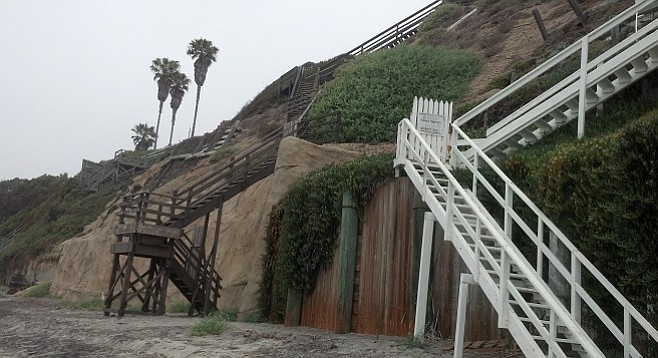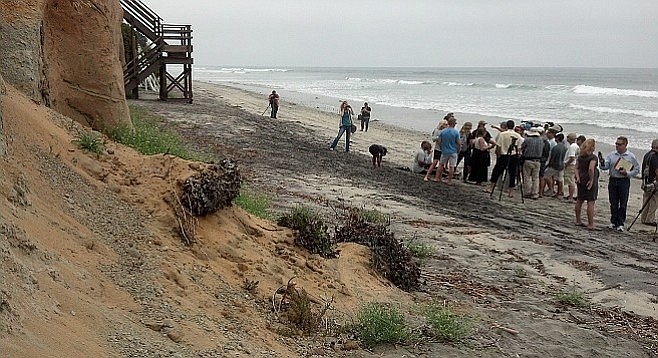 Facebook
Facebook
 X
X
 Instagram
Instagram
 TikTok
TikTok
 Youtube
Youtube

An Encinitas bluff tour organized by Surfrider San Diego drew a host of media and disgruntled oceanfront homeowners to Grandview Beach on Monday afternoon (June 8).
Surfrider representatives had organized the tour to tout their support for a California Coastal Commission brief submitted to the state Supreme Court in anticipation of a fourth hearing regarding the construction of a retaining wall on the beach by two homeowners, Barbara Lynch and Tom Frick.

When an existing seawall was destroyed in a 2010 storm, the pair applied to the commission for a permit to rebuild the wall and a private staircase leading from their residences to the beach below, as most homes in the area are equipped with. The commission issued a wall permit valid for 20 years, reserving the right to revisit the wall's approval after two decades. They denied the staircase permit, noting local planning decisions that call for private beach access points to be phased out in favor of public access points.
The owners cried foul, claiming that they should have a right to rebuild the stairs despite local planning guidelines because the California Coastal Act contains provisions allowing for "replacement of structures destroyed by disasters." They further argued that the commission's reserving the right to review the wall's coastal impact in the future was improper, and that owners should have a permanent right to protect their structures from erosion under the Coastal Act.
Judge Earl H. Maas III of San Diego Superior Court agreed, striking down the commission's decision in March 2013. The commission appealed, winning a reversal of that decision in September 2014.
"The Coastal Act has important protections to allow for public access along the beach for recreational resources," said Surfrider legal director Angela Howe. "As surfers will tell you, once water starts to hit up against a wall, refraction occurs and it obliterates not only sandy beaches but the waves we all enjoy.
"We feel it's important the public understand the negative impacts of seawalls and the potential impact of decisions like this case. Coastal communities deserve that knowledge."
The matter now heads to the state supreme court, where commission representatives will argue once again that it's important to review existing seawalls from time to time, as new erosion-control technologies that cause less damage to the beach below become available. They've also asserted that some natural erosion is both expected and an important factor in keeping the beaches below bluffs supplied with sand.

"This is a people problem, not a natural one," said Tom Cook, chair of Surfrider's beach-preservation committee. "Erosion isn't a sand problem, it's a natural process. That's what these [seawalls] are trying to protect against."
A handful of bluff-top property owners, both local and from other areas of San Diego, expressed concern that any ruling that might lead to future challenges on their seawalls could lead to falling property values or even the conclusion that sea-level rise could mean that indefinite defense of their homes could be infeasible.
"Many years ago, as the bluffs eroded, the rocks that were once part of the bluff system became some of the most iconic features here in San Diego," said Cook, lending support to those fears. "Our tidepools, rock reefs offshore that provide surf breaks, they were born from bluff erosion. It's part of our history, and it's part of what defines the beach culture here in San Diego."
Residents disagreed, with one owner insisting that natural erosion contributes "a very minor amount" of sand to the beach, comparing the tan sandstone above to the black-and-white beach sand, much of it hauled in as part of beach-replenishment projects seawall owners partially finance through permitting fees to mitigate the negative impact of their walls on the beaches below.
A ruling on the matter isn't expected until later this year or sometime in early 2016.


An Encinitas bluff tour organized by Surfrider San Diego drew a host of media and disgruntled oceanfront homeowners to Grandview Beach on Monday afternoon (June 8).
Surfrider representatives had organized the tour to tout their support for a California Coastal Commission brief submitted to the state Supreme Court in anticipation of a fourth hearing regarding the construction of a retaining wall on the beach by two homeowners, Barbara Lynch and Tom Frick.

When an existing seawall was destroyed in a 2010 storm, the pair applied to the commission for a permit to rebuild the wall and a private staircase leading from their residences to the beach below, as most homes in the area are equipped with. The commission issued a wall permit valid for 20 years, reserving the right to revisit the wall's approval after two decades. They denied the staircase permit, noting local planning decisions that call for private beach access points to be phased out in favor of public access points.
The owners cried foul, claiming that they should have a right to rebuild the stairs despite local planning guidelines because the California Coastal Act contains provisions allowing for "replacement of structures destroyed by disasters." They further argued that the commission's reserving the right to review the wall's coastal impact in the future was improper, and that owners should have a permanent right to protect their structures from erosion under the Coastal Act.
Judge Earl H. Maas III of San Diego Superior Court agreed, striking down the commission's decision in March 2013. The commission appealed, winning a reversal of that decision in September 2014.
"The Coastal Act has important protections to allow for public access along the beach for recreational resources," said Surfrider legal director Angela Howe. "As surfers will tell you, once water starts to hit up against a wall, refraction occurs and it obliterates not only sandy beaches but the waves we all enjoy.
"We feel it's important the public understand the negative impacts of seawalls and the potential impact of decisions like this case. Coastal communities deserve that knowledge."
The matter now heads to the state supreme court, where commission representatives will argue once again that it's important to review existing seawalls from time to time, as new erosion-control technologies that cause less damage to the beach below become available. They've also asserted that some natural erosion is both expected and an important factor in keeping the beaches below bluffs supplied with sand.

"This is a people problem, not a natural one," said Tom Cook, chair of Surfrider's beach-preservation committee. "Erosion isn't a sand problem, it's a natural process. That's what these [seawalls] are trying to protect against."
A handful of bluff-top property owners, both local and from other areas of San Diego, expressed concern that any ruling that might lead to future challenges on their seawalls could lead to falling property values or even the conclusion that sea-level rise could mean that indefinite defense of their homes could be infeasible.
"Many years ago, as the bluffs eroded, the rocks that were once part of the bluff system became some of the most iconic features here in San Diego," said Cook, lending support to those fears. "Our tidepools, rock reefs offshore that provide surf breaks, they were born from bluff erosion. It's part of our history, and it's part of what defines the beach culture here in San Diego."
Residents disagreed, with one owner insisting that natural erosion contributes "a very minor amount" of sand to the beach, comparing the tan sandstone above to the black-and-white beach sand, much of it hauled in as part of beach-replenishment projects seawall owners partially finance through permitting fees to mitigate the negative impact of their walls on the beaches below.
A ruling on the matter isn't expected until later this year or sometime in early 2016.
Comments